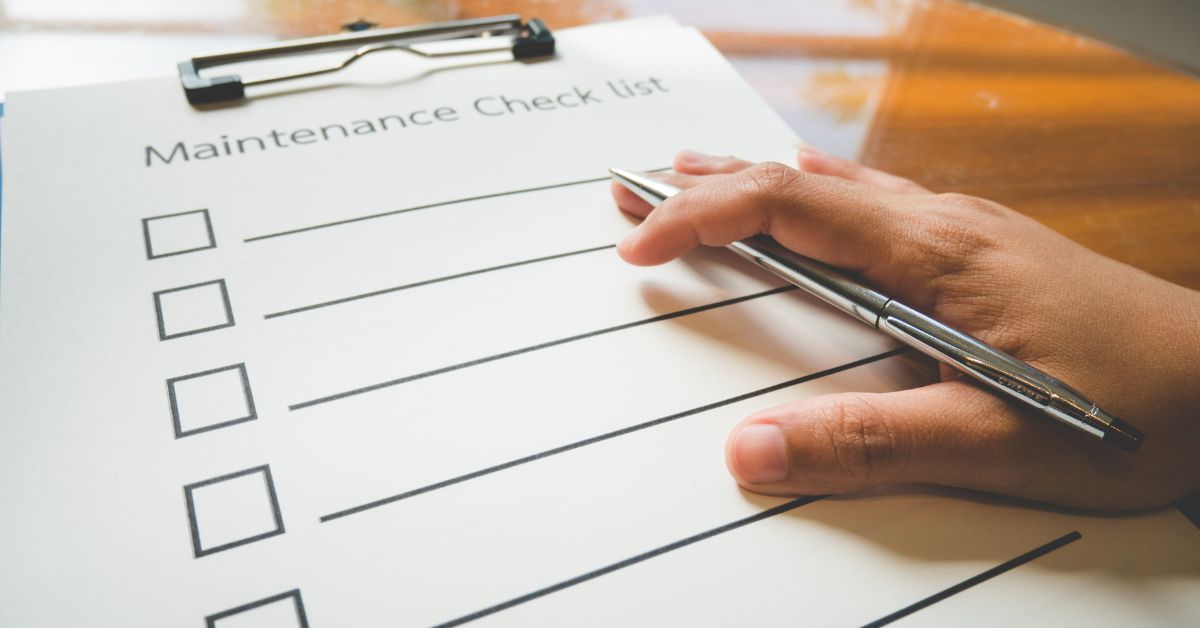The Ultimate Garage Door Maintenance Checklist for Homeowners

What’s the most frequently used entrance in your home? Surprisingly, it’s not your front door—it’s your garage door, operating over 1,500 times each year. Yet this hard-working system often goes unnoticed until something breaks.
The good news is that you can prevent many garage door problems with simple maintenance steps.
But before you tackle any garage door maintenance with our checklist, you’ll need to understand some crucial safety guidelines.
Safety First: Before You Begin
Would you try fixing your car’s engine without proper knowledge? Your garage door is just as complex and potentially dangerous. At 150-300 pounds of moving weight and components under extreme tension, one wrong move could lead to an unexpected injury.
If you hear strange noises or notice uneven movement, it’s time to call Thomas V. Giel Garage Doors. Remember, attempting complex repairs yourself could void your warranty or create dangerous situations.
With that said, let’s dive into our garage door upkeep checklist.
Garage Door Maintenance Checklist
A simple maintenance checklist can help you spot problems before they become expensive emergencies, helping you save thousands in costly repairs. Your garage door gives clear warning signs when it needs attention—you just need to know what to look for.
1. Visual Inspection
A thorough visual inspection can save you from costly repairs and keep your family safe. Here’s what you need to check during your garage door visual inspection.
- Start with the Door Panels: Examine each panel for cracks, dents, or warping. Pay attention to gaps between panels that could let in drafts or moisture. These gaps often indicate alignment problems that worsen over time.
- Check All Hardware: Your door’s hardware tells you a lot about its health. Hinges and brackets should be firmly attached. Tracks must be straight and debris-free. Rollers should spin freely without wobbling. And cables must be taut without fraying.
- Test Safety Systems Your door’s safety features protect your family every day. Photo eye sensors should be clean and aligned. The manual release handle must work smoothly. And the auto-reverse feature needs monthly testing.
- Inspect Weather Protection Run your hand along the weatherstripping. Feel for gaps, cracks, or brittle sections that could let in cold air or moisture.
Once you’ve completed your visual inspection, you’ll need to clean and lubricate key components to keep everything running smoothly.
2. Cleaning and Lubrication
Did you know that most garage door problems start with poor lubrication? A properly cleaned and lubricated door operates quietly and efficiently, while a neglected one can lead to expensive repairs.
Follow these upkeep tips to keep your garage door running smoothly:
- Choose the Right Product Use only silicone-based or manufacturer-recommended lubricants. Avoid WD-40–it removes necessary grease and attracts dirt. Apply sparingly and wipe away excess to prevent drips.
- Clean First, Lubricate Second: Start with a Clean Surface. Use mild soap and water on your door panels. Work in the direction of the grain on steel doors to prevent scratches. Never use harsh chemicals that could damage the finish.
- Clean All Moving Parts. Keep these components clean and debris-free: tracks (use a dry cloth only), rollers and bearings, hinges and brackets, and photo eye sensors.
- Where to Lubricate: Focus on these critical points: roller bearings (not the tracks), panel hinges, spring bearings, lock mechanisms, and the chain or belt drive.
Now that your door moves smoothly, let’s look at the mechanical adjustments that keep it operating safely and efficiently.
3. Mechanical Inspections
Let’s examine the critical mechanical components that keep your door operating safely.
While some tasks require professionals like Thomas V. Giel Garage Doors, you can perform several important checks yourself.
- Track Alignment: Your door’s tracks must be perfectly aligned for smooth operation. Check that both tracks are level and have equal spacing from the door. If you hear rubbing noises or notice the door slowing at certain spots, this often indicates misaligned tracks.
- Roller Condition: Examine your rollers for wear, chips, or cracks. Properly functioning rollers should spin freely without wobbling. While you can lubricate rollers yourself, replacement should be done by professionals when they reach their cycle limit.
- Testing Door Balance: With the opener disconnected, manually lift your door halfway—it should stay in position. If it drops or rises on its own, your springs need professional adjustment. Never attempt to adjust springs yourself, as they store enormous tension that can cause serious injury.
- Hardware Check: Tighten all accessible mounting hardware monthly. Inspect hinges and brackets for loose connections. Check for unusual noises during operation. And verify that the manual release mechanism is working properly.
While you can handle many of the maintenance tasks above yourself, some jobs require professional expertise to avoid dangerous situations.
Why Choose Professional Service
Why trust your garage door to just anyone? Since 1950, Thomas V. Giel Garage Doors has safeguarded Pittsburgh families with expert service and professional care.
Our certified technicians bring decades of experience to every service call, spotting potential problems before they become expensive emergencies.
Don’t wait for your garage door to fail. Schedule your professional maintenance with Pittsburgh’s most trusted garage door experts or visit us at our Gibsonia location today for 24/7 emergency service.
